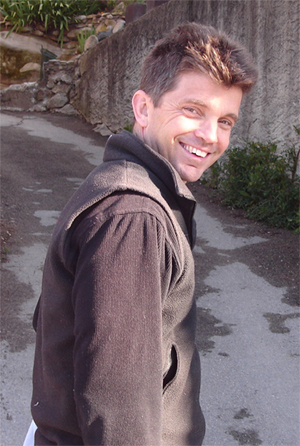 In memory
In memory
Professor Simon Thirgood
6 December 1962 – 30 August 2009
Tragically, Simon Thirgood, 46, died in Ethiopia on Sunday 30th August, when the building he was in collapsed during a sudden storm. Simon was a highly respected ecologist, deeply committed to conservation issues at home and abroad, and passionate about helping to make the world a better place. He was in Ethiopia setting up a project to build community capacity conserving and monitoring biodiversity, funded by the UK Darwin Initiative.
Simon was born in Liberia on 6th December 1962, and brought up in Vancouver, Canada, where his father, J.V. Thirgood, was a Professor of Forestry Policy at University of British Columbia. His father held strong views about the importance of forestry for the rural economy, and consequently Simon developed at a very young age, insights into the relationships between the natural, social and economic sciences for sustainable land management, which he would deploy with distinction in later years.
Indeed, his father’s influence was such that Simon had to study as an undergraduate in Scotland, and so, in 1980, he came to read Zoology at Aberdeen. Many fellow students remember a larger than life, highly principled individual with a mischievous sense of humour, and morale boosting disposition, who was steeped in the traditions of the University’s Lairig Club (the UK’s most active university mountaineering club). Simon became an active and accomplished mountaineer, climbing some classic routes in the Cairngorms, notably Djibangi and Grey Slab. Years later, he would spend New Year with former Club members, such as Andy Wightman (author of Who owns Scotland?), typically welcoming the year ahead with a dip followed by a hefty dram!
After graduating Simon worked off-shore, monitoring divers on the bottom of the North Sea, to earn enough money to be able to afford to volunteer as a research assistant at the Institute of Terrestrial Ecology (ITE) Banchory. The off-shore work gave him the time to read Krebs & Davies seminal book Behavioural Ecology, while the research on the ecology of mountain hares in the Cairngorms with Ray Hewson, and the use of coniferous plantations by red and roe deer, with Brian Staines led, to the publication of his very first two scientific papers. That early training set him apart as a potential PhD student, and in 1990 he completed his thesis on the Alternative mating strategies of fallow deer at the University of Southampton, under the supervision of Rory Putman. Simon’s studies involved a lot of pre-dawn starts, especially in autumn during the rut, with him driving deep into the New Forest in his old, battered mini van. He recognised all the fallow bucks, and in the presence of colleagues got excitedly animated about the subtleties of the lek. He rapidly developed an academic persona, churning out papers, but maintaining his zest for life – and for Scotland – regaling people endlessly and vividly about his climbing exploits. He was, as one close friend remarked, ‘a good talker’!
Simon might have become a specialist behavioural ecologist, with a strong understanding of evolutionary theory, honed in lively arguments with Tim Clutton-Brock FRS, during his first post-doc at Cambridge, an investigation of the mating system of black lechwe in Zambia. However, short-term funding necessitated that he move on, and Simon seized the opportunity to broaden his experience into conservation biology, literally ‘moving up the road’ to Birdlife International. There, he worked in the Putting Biodiversity on the Map project, which was very influential in the debate leading up to the 1992 Rio Earth Summit.
The need for a strong evidence base and pragmatic solutions to conservation conflicts, at a range of scales around the globe, became an inspiration for Simon’s continuing work. In 1992, he returned to Scotland to work for the Game Conservancy Trust, studying the controversial interactions between moorland management for driven grouse shooting and the conservation of birds of prey, under the direction of Ian Newton FRS and Peter Hudson FRS. This Langholm-based research culminated in a landmark publication - Birds of Prey and Red Grouse (1997), co-authored with his close friend and colleague, Steve Redpath. Founded on many hundreds of days spent in the field observing raptors, this painstaking Joint Raptor Study (JRS), as it became known, demonstrated incisively that numbers of raptors, in particular hen harriers, could reach levels where red grouse numbers fell to a level where a moor was no longer viable for driven grouse shooting. Following on from this, and again with Steve, Simon undertook a pioneering research trial involving the provisioning of alternative food for hen harriers, to divert them from red grouse, which demonstrated a marked decline in the take of grouse chicks. A decade after the original JRS report, a new project, with both Simon and Steve among the group of advisers, began at Langholm in a climate of hope. Active moorland management resumed with the employment of keepers, and detailed monitoring of the habitat, wildlife and game interests is underway. Moreover, the legacy of the work is that RSPB have had a fundamental change of heart in their policies, accepting that the translocation of harriers may be a solution to some conflicts.
During his employment with the Game Conservancy Trust, Simon worked alongside Karen Laurenson, a vivacious, veterinary epidemiologist studying the tick borne disease, louping ill, which can decimate grouse populations. Karen had maintained research links with projects in Africa and, as their friendship grew, they explored together a number of issues, including the threat of Ethiopian wolves becoming extinct from rabies transmitted by domestic dogs. While Karen moved on to develop this work, as a lecturer at the Royal Dick Veterinary College in Edinburgh, Simon moved to a Research Fellowship at the Centre for Conservation Science, a joint initiative of the Universities of Stirling and St. Andrews, funded by the Scottish Funding Council. Within a couple of years a great opportunity arose to share their common commitment to conservation in Africa; they both landed jobs working for the Frankfurt Zoological Society, based in the Serengeti National Park. Simon had responsibilities for projects based in Tanzania, Ethiopia and Zambia, and relished the opportunities to get stuck into the fundamentals of practical work guided by science. Although, the Serengeti is an ecologist’s heaven, it has its challenges for rearing a young family. As their children approached school age, Simon was open to being head-hunted to the post of Head of Ecology at the Macaulay Land Use Research Institute.
So, exactly 20 years after he graduated from Aberdeen, Simon returned to the ‘Granite City’. At the same time his prowess as an applied ecologist was recognized by the British Ecological Society when he was appointed an Editor of the Journal of Applied Ecology. His career blossomed, he notched up more than 100 scientific publications, and he took great joy in continuing his interest in conservation in Africa, co-editing the book People and Wildlife: Conflict or Co-existence? His interest in mountain hares was reignited, and he began to take an especially keen interest in their management and conservation.
While Simon was a natural leader he was an equally great collaborator. Most recently, through his part secondment to the Aberdeen Centre for Environmental Sustainability, a joint venture between the University of Aberdeen and the Macaulay Institute, he had won funding for two multi-national EU projects on sustainable hunting in Europe and Africa. Earlier this year, his scholarship and teaching, particularly in the training of PhD students, was recognised by the award of an Honorary Professorship at the University of Glasgow, where he worked closely with Dan Haydon, FRSE.
Simon was a wise, if at times caustic judge of others’ work, and unusually generous with his time spent helping early career researchers, who appreciated his directness, enthusiasm and 'get up and go', which made him an inspiring role model. He was in the camp of irreverent opposition to bureaucracy, and fulminated over the fineries of budget and human resource management. He hated hierarchies and pomposity, once asking a rather garrulous Chief Executive of an environment agency why he hadn’t published his evidently important views on human-nature conflicts in something more prominent than a Council paper!
Simon spoke increasingly persuasively of the need to foster greater education opportunities in the developing world. He could see the importance of integrating the natural and social sciences, borne in no small part out of his raw experiences in Africa. Highly active and productive, this year alone saw more than ten publications with colleagues, including their latest contributions to the raptor-grouse debate. In the words of his mentor, Ian Newton, ‘Simon was an outstanding field ecologist, as much at home with birds as with mammals’. Indeed he was, as well as being highly principled, energetic, articulate, engagingly amusing and highly intelligent, and caring passionately about wildlife, society and, most of all, his friends and family. While on holiday with his extended family last month, one of the adults present commented, ‘how wonderful Simon was with the children’. He reveled in playing the ‘pied piper’ and was held in awe as he organised games and introduced them to the great outdoors. Our thoughts and condolences go to Karen, their two daughters, Pippa and Katie, and their wider family, who must be immensely proud of an exceptional person.
|
Updated: 23 Jan 2024, Content by: SDA, DBAT and SMR
|



